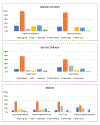Statewide efforts to address the opioid epidemic: Results from a national survey of single state agencies
- PMID: 38336265
- PMCID: PMC11060908
- DOI: 10.1016/j.josat.2024.209309
Statewide efforts to address the opioid epidemic: Results from a national survey of single state agencies
Abstract
Background: Single State Agencies (SSAs) are at the forefront of efforts to address the nation's opioid epidemic, responsible for allocating billions of dollars in federal, state, and local funds to ensure service quality, promote best practices, and expand access to care. Federal expenditures to SSAs have more than tripled since the early years of the epidemic, yet, it is unclear what initiatives SSAs have undertaken to address the crisis and how they are financing these efforts.
Methods: This study used data from an internet-based survey of SSAs, conducted by the University of Chicago Survey Lab from January to December 2021 (response rate of 94 %). The survey included a set of 14 items identifying statewide efforts to address the opioid epidemic and six funding sources. We calculated the percentage of SSAs that supported each statewide effort and the percentage of SSAs reporting use of each source of funding across the 14 statewide efforts.
Results: Treatment of opioid-related overdose figured most prominently among statewide efforts, with all SSAs providing funding for naloxone distribution and all but one SSA supporting naloxone training. Recovery support services, Project ECHO, and Hub and Spoke models were supported by the vast majority of SSAs. Statewide efforts related to expanding access to medications for opioid use disorder (MOUD) received somewhat less support, with 45 % of SSAs supporting mobile methadone/MOUD clinics/programs and 70 % supporting buprenorphine in emergency departments. A relatively low proportion of SSAs (54 %) provided support for syringe services programs. State Opioid Response (SOR) funds were the most common funding source reported by SSAs (57 % of SSAs), followed by block grant funds (19 %) and other state funding (15 %).
Conclusion: Results highlight a range of SSA efforts to address the nation's opioid epidemic. Limited adoption of efforts to expand access to MOUD and harm reduction services may represent missed opportunities. The uncertainty over reauthorization of the SOR grant post-2025 also raises concerns over sustainability of funding for many of these statewide initiatives.
Keywords: Harm reduction; Medications; Opioid use disorder; Overdose; Public funds; Single state agencies.
Copyright © 2024 Elsevier Inc. All rights reserved.
Conflict of interest statement
Declaration of competing interest None to declare.
Figures
Similar articles
-
System dynamics modeling to inform implementation of evidence-based prevention of opioid overdose and fatality: A state-level model from the New York HEALing Communities Study.Int J Drug Policy. 2025 Aug;142:104843. doi: 10.1016/j.drugpo.2025.104843. Epub 2025 May 27. Int J Drug Policy. 2025. PMID: 40435932
-
Approaches, Barriers, and Facilitators in Statewide Initiative to Combat Opioid Overdose: A Narrative Review of Ohio's Experiences During the HEALing Communities Study.Prehosp Emerg Care. 2025;29(4):519-524. doi: 10.1080/10903127.2025.2451214. Epub 2025 Jan 17. Prehosp Emerg Care. 2025. PMID: 39786790 Clinical Trial.
-
Systematic Evaluation of State Policy Interventions Targeting the US Opioid Epidemic, 2007-2018.JAMA Netw Open. 2021 Feb 1;4(2):e2036687. doi: 10.1001/jamanetworkopen.2020.36687. JAMA Netw Open. 2021. PMID: 33576816 Free PMC article.
-
Naloxone's role in the national opioid crisis-past struggles, current efforts, and future opportunities.Transl Res. 2021 Aug;234:43-57. doi: 10.1016/j.trsl.2021.03.001. Epub 2021 Mar 5. Transl Res. 2021. PMID: 33684591 Free PMC article. Review.
-
Estimating naloxone need in the USA across fentanyl, heroin, and prescription opioid epidemics: a modelling study.Lancet Public Health. 2022 Mar;7(3):e210-e218. doi: 10.1016/S2468-2667(21)00304-2. Epub 2022 Feb 10. Lancet Public Health. 2022. PMID: 35151372 Free PMC article. Review.
Cited by
-
Reported outcomes from a community naloxone training and distribution program.Drug Alcohol Depend Rep. 2025 May 6;15:100341. doi: 10.1016/j.dadr.2025.100341. eCollection 2025 Jun. Drug Alcohol Depend Rep. 2025. PMID: 40487295 Free PMC article.
-
Peer-Assisted Telemedicine for Hepatitis C (PATHS): Process evaluation results from a State Opioid Response-funded program.J Subst Use Addict Treat. 2024 Dec;167:209510. doi: 10.1016/j.josat.2024.209510. Epub 2024 Sep 6. J Subst Use Addict Treat. 2024. PMID: 39243982
References
-
- Aspinall EJ, Nambiar D, Goldberg DJ, Hickman M, Weir A, Van Velzen E, Palmateer N, Doyle JS, Hellard ME, & Hutchinson SJ (2014). Are needle and syringe programmes associated with a reduction in HIV transmission among people who inject drugs: A systematic review and meta-analysis. International Journal of Epidemiology, 43(1), 235–248. 10.1093/ije/dyt243 - DOI - PubMed
-
- Center for Behavioral Statistics and Quality. (2022). Results from the 2021 National Survey on Drug Use and Health: Detailed Tables. Substance Abuse and Mental Health Services Administration.
Publication types
MeSH terms
Substances
Grants and funding
LinkOut - more resources
Full Text Sources
Research Materials
Miscellaneous




